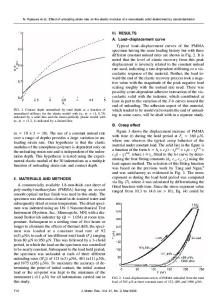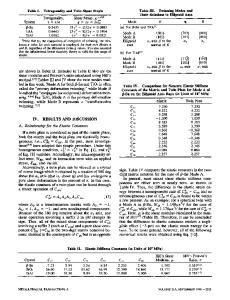On the nature of deformation of a crystalline solid: II. the absolute strain rate in elastic deformation
- PDF / 366,592 Bytes
- 4 Pages / 613 x 788.28 pts Page_size
- 33 Downloads / 297 Views
THE
widely used d e f i n i t i o n s in m e c h a n i c a l d e f o r m a tion p h e n o m e n a pose a n a p p a r e n t p a r a d o x . Thus in a finite s p e c i m e n of i n i t i a l length lo, d e f o r m e d at a cons t a n t end velocity v, we have an e n g i n e e r i n g s t r a i n , defined as _
co
vt to
[1]
or t r u e s t r a i n , defined as c t = ln(1 + %)
[2] DISCRETE DEFORMATION: SEMI-INFINITE SOLID
where t e n s i l e s t r a i n (hence also the c o r r e s p o n d i n g s e n s e of v e l o c i t y v) a r e t a k e n as p o s i t i v e . It follows that the c o r r e s p o n d i n g s t r a i n r a t e s a r e
v Eo -- l-~'
[a]
and v
of the s p e c i m e n . As has b e e n suggested m o r e ext e n s i v e l y in the p r e c e d i n g p a p e r a the d e f o r m a t i o n of a c r y s t a l l i n e m a t e r i a l is f u n d a m e n t a l l y a d i s c o n t i n u o u s p r o c e s s , and t a k e s place in d i s c r e t e i n c r e m e n t s of s t r a i n , s t r e s s , and t i m e . We s h a l l now show how the c u r r e n t l y u n s a t i s f a c t o r y s i t u a t i o n with r e s p e c t to the r a t e of d e f o r m a t i o n can be r e s o l v e d when the d i s c r e t e n a t u r e of the p r o c e s s is p r o p e r l y t a k e n into account, and d e r i v e the concept of an absolute s t r a i n r a t e .
~o
[41
gt - lo + v t - 1 + Eo "
F o r s m a l l v a l u e s of s t r a i n , % 0 be i m p a r t e d to the s u r f a c e at any t i m e t > 0. The r e s u l t i n g d i s p l a c e m e n t of the s u r f a c e plane is U(Xo, t) = v t . However, the next plane xl is not affected u n t i l t r e a c h e s the value of tl = d / c , at which i n s t a n t this plane in t u r n a c q u i r e s the velocity v. T h r o u g h o u t the t i m e i n t e r v a l 0 < t < d / c , t h e r e f o r e , the plane x o is b e i n g d i s p l a c e d r e l a t i v e to xl. At any s u b s e q u e n t t > d/c, however, both the p l a n e s move at the s a m e velocity v, but with t h e i r now changed s p a c i n g of d 9 (1 + v / c ) . In g e n e r a l we can e x p r e s s the d i s p l a c e m e n t of the m - t h atom plane as a function of t i m e by the following r e lationship:
1
U ( X m , t) = 2 v 9 ( t -
tm) "
1 +
where t m = m 9 d / c . T h e r e f o r e u ( X , n , t) r e m a i n s i d e n t i c a l l y z e r o for any t < t i n , and u ( x m , t) = v 9 ( t -
t.~)
[6]
for a n y t > t m . The r e l a t i o n s h i p [6] above r e p r e s e n t s the change of the s p a t i a l d i s p l a c e m e n t of x m with t i m e . However, in the t i m e i n t e r v a l t m < t < t m § x only the p l a n e s at x < Xrn § ~ move with the velocity v. T h e plane x m + ~ and a l l other following p l a n e s ahead of the wave f r o n t r e m a i n s t a t i o n a r y . T h e r e f o r e d u r i n g this t i m e i n t e r v a l the s p a c i n g b e t w e e n x m and x m . ~ v a r i e s in a c c o r d with [7]
d ( t ) = d + U ( X m , t)
t h e r e f o r e the r e s u l t i n g s
Data Loading...











